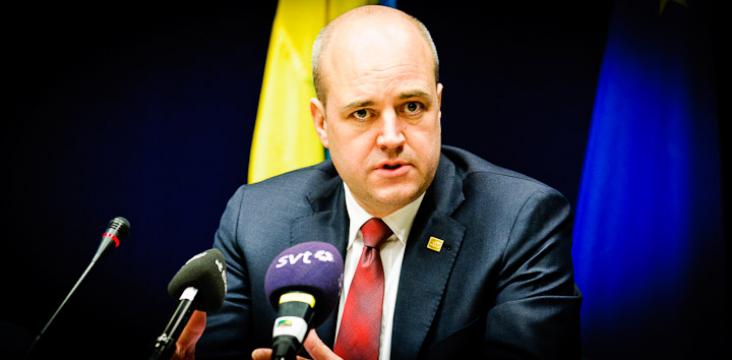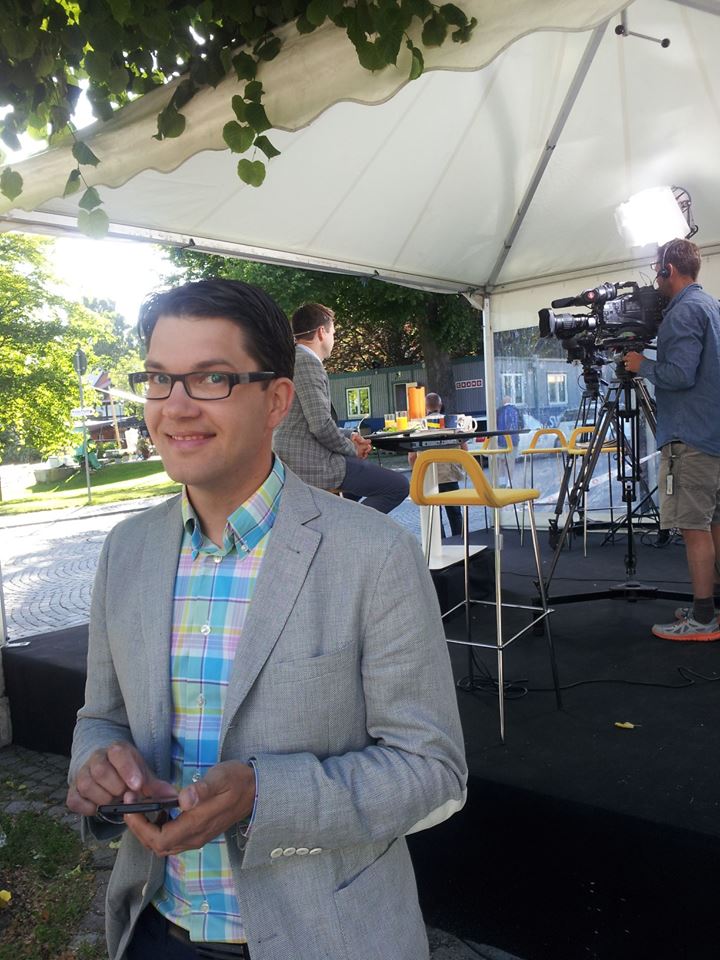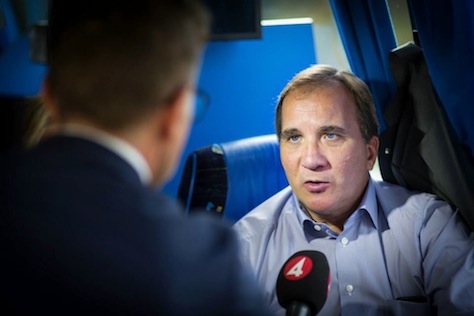When Swedes finish voting on Sunday in general election, they might find that, to their astonishment, the only party with the seats to deliver a majority coalition is the one that both the right and left have treated as politically radioactive for years.![]()
In the final days of the campaign, the race has tightened between the four-party center-right alliance headed by two-term prime minister Frederik Reinfeldt (pictured above) and the loose confederation of social democrats, greens and socialists that would rally behind Stefan Löfven, the former labor union leader who now heads Sweden’s center-left Sveriges socialdemokratiska arbetareparti (Swedish Social Democratic Party), which essentially created the Swedish social welfare state in the 20th century.
If the results are close, it could leave the balance of power in the hands of the far-right, anti-immigrant Sverigedemokraterna (SD, Sweden Democrats), even though the party entered the final week of the campaign crippled after news reports revealed racist online commentary of several of the party’s candidates.
Though Löfven’s Social Democrats (and the left, generally) have held a polling lead for much of the the past year, a September 1-4 Sifo poll from showed the left’s generic lead falling to less than 4.9%. A more recent September 8-9 Sifo survey showed the left recovering a greater margin of 7.8%. But up to one-third of the Swedish electorate may still be undecided going into the election on Sunday, making predictions difficult.
Despite Löfven’s lead, many voters approve of Reinfeldt’s performance over the past eight years, most especially as his record relates to the Swedish economy. Sweden has emerged from both the 2008-09 global financial crisis and the 2010-12 eurozone crisis with stronger economic growth than much of the rest of the European Union. While unemployment is still probably too high at around 8%, the rate is slowly declining. But Swedes don’t dislike Reinfeldt. It’s that that Swedes are ready for a change, and Löfven’s moderate social democratic approach would bring more continuity than rupture.
* * * * *
RELATED: One month out, Löfven and Social Democrats lead in Sweden
* * * * *
Though the two Sifo polls this month showed support for the Sweden Democrats dropping from 10.4% to 8.9%, even a ‘poor’ showing would eclipse their previous high point in the 2010 election, when they won 5.7% of the vote. The 2010 breakthrough was a watershed moment for Sweden’s far right — much to the dismay of the rest of the political spectrum. Suddenly, a far-right party that had never held any seats in the Riksdag, Sweden’s parliament, now held 20.
So even if the Sweden Democrats under-perform in the 2014 election (they won around 9.7% in the May European elections), they could still hold a large enough bloc of seats to deny either the Reinfeldt-led right or the Löfven-led left a majority.
Though the current center-right government has only a minority in the Riksdag, it has often unofficially leaned on the Sweden Democrats for support, though it’s also turned to the Miljöpartiet (Green Party) as necessary on issues like refugees and asylum.
Who are the Sweden Democrats and what do they stand for?
A tale of four parties
To understand the answer to that question, it’s helpful to grasp the spectrum of Nordic far-right parties, which are typically (and mistakenly) lumped together as a homogeneous group.
In Norway, the Framstegspartiet (FrP, Progress Party) is based in the anti-tax movement of the 1970s and only more recently adopted anti-immigration and anti-Islam stands. Under the moderating leadership of Siv Jensen, the party successfully entered government last year, on the strength of over 16% of the vote in the September 2013 elections. Jensen today serves as Norway’s finance minister. Norway’s conservative prime minister, Erna Solberg, never once considered a ‘grand coalition.’
The Dansk Folkeparti (DF, Danish People’s Party) has a similar pedigree, though it’s perhaps more nationalist. It too has roots in anti-tax activism and has embraced protectionism, populism and anti-immigration sentiment. As in Norway, the DF has bolstered otherwise moderate center-right governments. Like the Progress Party, it’s also capable of amassing more than token support. In the May European elections, the DF won 26.2%, more support than any other party in Denmark.
On the other side of the spectrum is the nationalist Perussuomalaiset (PS, Finns Party), which actually has its roots in the left-wing agrarian rural politics of the mid-20th century. Polls show that the Finns Party, the country’s largest opposition party, currently enjoys around around 17% in advance of April 2015 elections.
The Swedish Democrats, however, have a much darker genesis. Founded in 1988 as the successor to a ‘Keep Sweden Swedish’ movement, the party was xenophobic from the outset, with nasty ties to neo-Nazi, white supremacist and fascist groups. In the 1990s, its leader Mikael Jansson tried to moderate the party and ban the nastier bits of neo-Nazi nostalgia, though it still cultivated ties with France’s xenophobic Front national (FN).
The Sweden Democrats enter the Riksdag
Jimmie Åkesson (pictured above), a photogenic 35-year-old who defeated Jansson to win the leadership in 2005, brought the party into the Swedish parliament for the first time in the 2010 election, in part by continuing Jansson’s moderating efforts — he replaced the old torch logo with a more innocuous blåsippa flower, for example.
It hasn’t been a smooth four years for the party. One MP was forced to leave the party’s caucus in the Riksdag in 2011 and he later died of a drug overdose. In 2012, video recordings were released of two additional MPs engaging in a racist argument with a comedian.
But the Sweden Democrats continue to draw much of their support in large part due to their opposition to current immigration policy and to the values of multiculturalism generally, including rights for the northern indigenous Sami people. Like many far-right movements in Europe, the Sweden Democrats have doubts about the European Union, oppose Sweden’s entry into the eurozone and would like to renegotiate Sweden’s membership in the European Union (it’s been a member only since 1995, when Finland and Austria also joined).
Geographically, the Sweden Democrats draw their greatest support in Sweden’s far south, particularly in the county of Skåne and its capital of Malmö.
The latest explosions of racism threaten to undo all of the work that leaders like Åkesson have done to eliminate the most extreme views from its candidates:
According to the Expressen revelations, party members have compared immigrants to monkeys and asylum seekers to vermin and parasites in online forums. The tabloid and the organization Researchgruppen this week stepped up their publication of the identities of anonymous commentators. The newspaper also published a photo of a local Sweden Democrats candidate wearing a swastika armband.
The revelations have forced eight SD candidate out of races across Sweden, and threaten to torpedo Åkesson’s plans to build on his 2010 triumph.
How the Swedish Democrats could effect the election on Sunday
Reinfeldt, in particular, has made Sweden’s acceptance of refugees seeking asylum in Sweden a key campaign issue, arguing that the cost of sheltering asylum-seekers from Syria and Iraq is one reason why his coalition hasn’t made addition spending pledges throughout the campaign, perhaps hoping to draw out the most egregious response from at least some of the Sweden Democrats:
“Show tolerance,” he urged referring to the increasing number of people fleeing wars in Syria and Iraq. “I know that this will cause friction. I therefore call on the Swedish people to show patience and open their hearts.” Reinfeldt cited the cost of taking care of asylum-seekers as one of the reasons why voters can expect no more spending pledges from the government before the September 14th election.
It’s a courageous stand for a prime minister who was always expected to lose the election. Though refugee policy isn’t in any doubt, it can be unpopular, especially in the southern port cities where immigrants and refugees often first arrive on Swedish shores. The country of 9.6 million may take in 100,000 refugees, mostly from the Middle East, in 2014 — a record high.
But it’s also a canny stand (whether by design or not). By emphasizing his government’s humane stand on the refugee issue, Reinfeldt could embolden anti-immigration voters to rally behind the Swedish Democrats and demonstrate to left-leaning voters that his center-right government can be every bit as compassionate as the Social Democrats.
If support for the Sweden Democrats is high enough to result in a hung parliament, there might just be a path for Reinfeldt to win a third term, making him the longest-serving prime minister since the beloved postwar Social Democratic leader, Tage Erlander, who led Sweden from 1948 to 1969.
It’s not as farfetched as it looks on the basis of current polls.
Yes, support for the Social Democrats would have to be incredibly subdued.
Yes, support for Reinfeldt’s Moderata samlingspartiet (Moderate Party) and for his allies, the liberal Folkpartiet liberalerna (Liberal People’s Party), the Centerpartiet (Centre Party), a libertarian, historically agrarian party and the Kristdemokraterna (Christian Democrats) would have to surge on the basis of last-minute deciders.
It’s not hard to believe that Löfven (pictured above) could encounter problems building a majority coalition with the Greens or even with the more socialist Vänsterpartiet (Left Party). Löfven has taken care not to repeat the party’s 2010 mistake of campaigning in a formal Red-Green alliance with the Left Party, a move that caused alarm among moderate voters in the last election. Turning to the Left to form a government this time around could alarm markets, despite the fact that Löfven and his likely finance minister, former tax agency head Magdalena Andersson, have telescoped that they intend to pursue a generally moderate course, with limited tax and spending increases.
Unlike Reinfeldt’s formal center-right coalition, the center-left would never be able to count on votes from the Swedish Democrats in an informal capacity.
That means, in essence, that if Löfven, together with the Greens (or possibly the Left as well), can’t build a Red-Green majority coalition, Reinfeldt may, against all odds, be headed for a third term.


